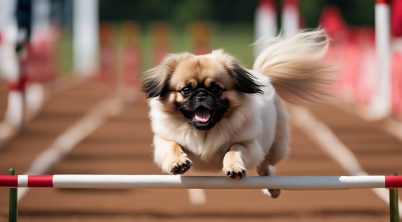Pekingese dogs, a toy breed known for their distinctive lion-like appearance and rolling gait, face several health challenges due to their unique physical structure. Among these, back leg problems are not uncommon and can significantly affect their quality of life. The breed’s characteristic long back and short legs play a role in predisposing them to conditions such as intervertebral disc disease (IVDD), which impacts their spinal health and can lead to issues in their hind limbs.
IVDD in Pekingese can result in a range of symptoms from mild discomfort to severe mobility issues. Owners might notice signs of pain, such as reluctance to move, jump, or play, and changes in behavior that indicate distress. In some cases, the condition can cause weakness or even paralysis in the back legs, necessitating prompt and often aggressive veterinary care. Maintaining a healthy weight and avoiding high-impact activities can help manage the risk of back leg problems in this breed.
Early identification and appropriate management of back leg issues are central to ensuring Pekingese dogs lead comfortable lives. Regular veterinary check-ups, along with a keen observation of any changes in movement or behavior, allow Pekingese owners to address these problems effectively. Treatments may vary from conservative methods like rest and anti-inflammatory medications to more invasive approaches such as surgery, depending on the severity of the condition.
Understanding Pekingese Back Leg Problems
Pekingese dogs, due to their unique body structure, are susceptible to several back leg problems that can affect their mobility and quality of life. The following sections detail the common causes of these issues and the symptoms to look out for.
Causes of Back Leg Issues
Intervertebral Disc Disease (IVDD): This condition is prevalent in Pekingese and can lead to back pain, weakness, and even paralysis of the hind legs. IVDD occurs when discs in the spine become herniated or degenerate, putting pressure on the spinal cord.
- Arthritis: Often a result of age or joint stress, arthritis can cause pain and lameness in a dog’s back legs.
- Hip Dysplasia: Common in many dog breeds, hip dysplasia in Pekingese can lead to arthritis or other joint problems, affecting the hind legs’ function.
These conditions might be exacerbated by the dog’s lifestyle, including diet and exercise habits, which can contribute to the severity of symptoms.
Identifying Symptoms
When a Pekingese is experiencing back leg problems, they might exhibit:
- Reluctance to Move: Hesitancy in walking, climbing, or jumping, which may indicate pain or discomfort.
- Abnormal Posture: A hunched back or other changes in how the Pekingese stands or moves can be signs of back leg issues.
- Lameness or Weakness: This manifests as a notable decrease in the strength or coordination of the hind legs.
Additionally, a Pekingese may show:
- Pain: Visible discomfort when their hind quarters are touched.
- Muscle Spasms: These can be indications of discomfort stemming from back leg problems.
The Role of Genetics and Breed Characteristics
The Pekingese breed, renowned for its dignified and affectionate character, possesses distinctive physical features bred over generations. These features contribute both to their charm and to certain health challenges, particularly concerning their back legs. Genetics plays a pivotal role, as the Pekingese’s compact build—short legs supporting a long, heavy body—is a result of selective breeding for these traits.
In this toy breed, such a body structure exacerbates the strain on the back legs and spine, predisposing these dogs to skeletal issues, including back leg problems. Similar concerns are present in other breeds with comparable body types, such as Dachshunds and Shih Tzus, indicating a shared genetic predisposition across breeds where the phenotype is one of a compact build.
Moreover, being a brachycephalic breed, the Pekingese’s characteristic conformation goes beyond facial structure to impact their overall musculoskeletal system. Close relative breeds such as Shih Tzus also share this type of conformation, emphasizing the role of breed characteristics in health issues.
Environmental factors play a secondary role in the expression of genetic predispositions. Factors like diet and exercise can either mitigate or exacerbate potential back leg problems. It’s crucial for owners to understand that while genetics set the stage, their stewardship can influence the longevity and quality of life for these dogs.
Effective Treatment Strategies
Effective treatments for Pekingese back leg problems typically involve a combination of veterinary interventions and thoughtful at-home care. It is essential to address both immediate pain relief and long-term management to improve quality of life.
Veterinary Interventions
For Pekingese suffering from back leg issues, the initial step should be a comprehensive examination by a veterinarian. Depending on the diagnosis, treatment options may include:
- Medication: Anti-inflammatory drugs are commonly prescribed to reduce swelling and pain. If an infection is present, the veterinarian may also prescribe antibiotics.
- Surgery: In severe cases, particularly those involving intervertebral disc disease, surgery may be necessary to correct the underlying problem and alleviate pain.
- Physical Therapy: Post-operative or as a standalone treatment, physical therapy can be crucial in strengthening the back legs and improving mobility.
At-Home Care and Management
Proper care at home is instrumental to the recovery and long-term health of a Pekingese with back leg issues. Owners can:
- Exercise: Engage in gentle, regular exercise to help maintain muscle strength without over-straining the back legs.
- Weight Management: Ensure the Pekingese maintains a healthy weight to reduce stress on the spine and legs.
- Comfortable Environment: Provide a supportive bed and minimize the need to jump or climb, which can exacerbate back leg problems.
These treatment strategies should always be discussed with and guided by a veterinarian to tailor the best approach for each individual dog’s needs.
Prevention and Long-Term Health
In safeguarding the health of a Pekingese’s back legs, preventive measures centered on proper exercise, diet, and consistent veterinary care are essential.
Exercise and Weight Control
Regular, gentle exercise is vital for maintaining a Pekingese’s leg health, but care must be taken to avoid excessive jumping which can put strain on their back and legs. Weight management is crucial, as obesity significantly increases the risk of back and leg problems. Owners should adhere to a routine of daily exercise such as short walks to keep their Pekingese fit without overexertion.
Dietary Considerations
A balanced diet with high-quality dog food that’s rich in nutrients can support joint health and aid in weight control. Incorporating foods with glucosamine can benefit joint maintenance, while foods that reduce inflammation can also be advantageous. Owners should:
- Ensure their Pekingese maintains a healthy weight to reduce stress on the legs.
- Consider supplements or foods that promote joint health as part of their daily diet.
Regular Veterinary Check-Ups
Routine veterinary visits enable early detection of any leg health issues. Vets might recommend preventative measures such as nutritional adjustments or specific exercises tailored to the dog’s needs. Veterinary care should include:
- Regular assessments of the Pekingese’s leg and back health.
- Monitoring for signs of discomfort or pain that could indicate issues such as arthritis.
Supporting Mobility and Quality of Life
When a Pekingese faces hind leg mobility issues, it’s crucial to support their movement and ensure they can enjoy life with minimal discomfort. This involves using adaptive equipment and making environmental modifications suitable for their needs.
Adaptive Equipment
Harnesses play a pivotal role in aiding a Pekingese’s mobility. A well-designed harness provides support without putting pressure on sensitive areas, allowing for safer movement and handling. Mobility harnesses often have handles to help lift and steady the dog, particularly when they struggle with steps or uneven surfaces. For those with more severe mobility issues, specially designed canine wheelchairs can offer a significant boost in movement and independence.
Harness Options:
- Basic Lift Harnesses
- Full-Body Support Harnesses
- Custom Wheelchair Solutions
Environmental Modifications
Adjusting the Pekingese’s living environment can drastically improve their quality of life. Ramps are essential for bypassing steps, enabling smooth access to favorite areas like couches or beds. Replacing stairs with ramps avoids the strain that steps can cause on their back and legs. Additionally, floors should be made non-slip to prevent falls and injuries that could further impair mobility.
Key Environmental Changes:
- Ramps: for couches, beds, and cars
- Non-slip Mats or Rugs
- Accessible Bedding and Rest Areas








